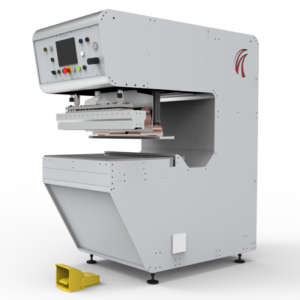Resistant welding
Resist welding: the basics
Depending on the type of material to be joined, the characteristics of a strong weld differ greatly.
When joining metals, it is necessary to produce a weld seam that is uniform in both width and thickness, either by melting the parts in contact or by adding metal. To be considered a strong weld, the bead must be free of cracks, crevices (risk of oxidation), blowholes and inclusions.
When assembling wood parts, even large ones, it is necessary to heat the surfaces to be welded to 170 degrees under friction and pressure of a few bars. At this temperature, the wood releases a monomer which acts like a glue, creating a highly resistant weld after the cooling phase.
When joining plastics, it is necessary to create heat either by an external heat input, or by the generation of heat by the surfaces themselves on which the welding process acts. The creation of a strong weld is linked to high-quality fusion of the surfaces in contact, thanks to a constant temperature evenly distributed along the entire length of the surfaces to be joined.
Whatever the nature of the materials to be joined by welding, the aim is to create strong, durable bonds between them. This is true if the parts or assemblies to be welded have the same mechanical and physico-chemical characteristics, or if, despite any differences in nature, they are compatible with each other.
The efficiency and precision of the welding procedure chosen, and consequently the achievement of a strong weld, are highly dependent on the specific properties of each of the materials to be welded. In the case of thermoplastics, which are widely used in industry, the characteristics that determine the quality and strength of assemblies are varied (modulus of elasticity, melting point, damping, melt flow capacity). In addition to these specific features, several other factors influence weldability. A distinction can be made between positive influences (glass beads, glass fibers) and negative influences (humidity, presence of additives).
Which plastics can be joined by strong welds?
Within the large family of plastic materials (thermosets, elastomers…), only thermoplastics can be joined by welding. The joining technologies used ensure solid, durable bonds between parts, thanks to molecular agitation generated not only on the surface, but also deep down. In fact, thermoplastics are made up of linear molecular chains that slide over one another. This physico-chemical characteristic means that welds are both uniform and homogeneous.
Thermoplastics fall into two distinct categories, both of which can be joined by welding: amorphous and semi-crystalline thermoplastics. Amorphous thermoplastics are transparent in appearance, containing no visible additives, while semi-crystalline thermoplastics are milky or opaque to the naked eye.
Whether amorphous or semi-crystalline, all the following thermoplastics can be joined by welding:
- EVA (ethylene vinyl acetate),
- PETG (polyethylene glycol terephthalate),
- PVC (polyvinyl chloride),
- PA (Polyamide),
- PC (Polycarbonate),
- PETP (thermoplastic polyester)
- PET (polyethylene terephthalate),
- PEEK (Polyetheretherketone),
- ABS (Acrylonitrile butadiene styrene),
- PS (polystyrene),
- PMMA (polymethyl methacrylate),
- PE (Polyethylene),
- PP (Polypropylene),
- …
The use of thermoplastic welding in many industrial sectors offers numerous advantages. It provides parts with high structural strength, thanks to welds that are resistant to a variety of stresses (wear, corrosion, impact). These assembly methods also enable plastic parts to be modified according to their intended use, with numerous possibilities in terms of shapes, but also in terms of production volumes. To meet these needs, Matrelec has developed a range of high-frequency welding presses and high-performance welding rails.

Which plastic welding methods are the most effective?
It’s worth remembering that the joining of several plastic parts, or of the various components of a plastic assembly, with a specialized adhesive is not a welding operation, despite its name ” cold welding”.
On the other hand, the plastic brazing method works to join together PVC/PVC (polyvinyl chloride), PMMA/PMMA (polymethyl methacrylate) or PVC/PMMA parts using PVC filler rods. However, this method of joining plastics cannot be considered a welding technique either.
The most widely used and effective thermoplastic welding methods are :
- Rotation welding (friction welding of a part held stationary with another pressurized via a circular movement on the first using an inertia tool or a pivot tool).
- Blade or mirror heating (welding of two parts by positioning them one on top of the other, separated by a gap into which a mirror heating element is inserted on both sides, enabling the melting temperatures of the materials to be joined to be reached).
- Ultrasonic welding (welding of two parts by inducing molecular agitation of their edges at a point of contact thanks to high-frequency oscillations ranging from 20 to 70 kHz induced by a welding head or vibrating tool called a sonotrode).
- High-frequency welding (instantaneous non-contact welding of several parts by creating molecular vibrations using a high-frequency electromagnetic field, generally 27.12 MHz, induced by one or more electrodes.
The most resistant plastic welds are generated by ultrasound and high-frequency molecular agitation, which modifies the structure of the material while creating continuity between the two surfaces being joined.
Matrelec’s high-frequency welding presses are designed and produced for industrial companies needing to weld thermoplastic parts or components at high production rates, in a partially or fully automated process.
